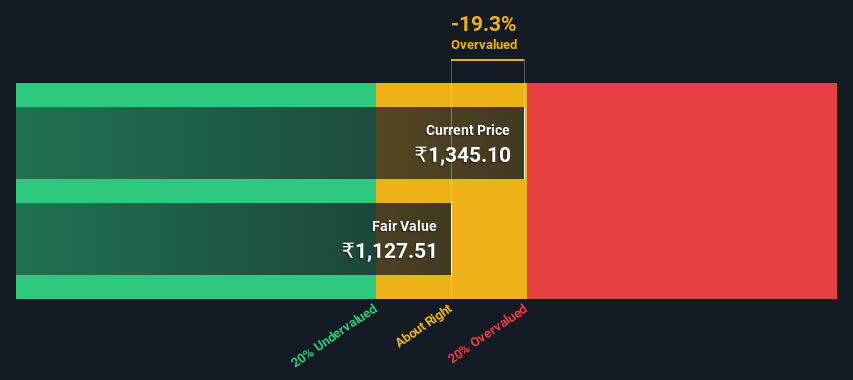- India
- /
- Oil and Gas
- /
- NSEI:GESHIP
A Look At The Fair Value Of The Great Eastern Shipping Company Limited (NSE:GESHIP)

Key Insights
- The projected fair value for Great Eastern Shipping is ₹1,128 based on 2 Stage Free Cash Flow to Equity
- With ₹1,345 share price, Great Eastern Shipping appears to be trading close to its estimated fair value
- When compared to theindustry average discount of -130%, Great Eastern Shipping's competitors seem to be trading at a greater premium to fair value
In this article we are going to estimate the intrinsic value of The Great Eastern Shipping Company Limited (NSE:GESHIP) by projecting its future cash flows and then discounting them to today's value. Our analysis will employ the Discounted Cash Flow (DCF) model. Believe it or not, it's not too difficult to follow, as you'll see from our example!
Companies can be valued in a lot of ways, so we would point out that a DCF is not perfect for every situation. Anyone interested in learning a bit more about intrinsic value should have a read of the Simply Wall St analysis model.
Check out our latest analysis for Great Eastern Shipping
What's The Estimated Valuation?
We use what is known as a 2-stage model, which simply means we have two different periods of growth rates for the company's cash flows. Generally the first stage is higher growth, and the second stage is a lower growth phase. In the first stage we need to estimate the cash flows to the business over the next ten years. Where possible we use analyst estimates, but when these aren't available we extrapolate the previous free cash flow (FCF) from the last estimate or reported value. We assume companies with shrinking free cash flow will slow their rate of shrinkage, and that companies with growing free cash flow will see their growth rate slow, over this period. We do this to reflect that growth tends to slow more in the early years than it does in later years.
Generally we assume that a dollar today is more valuable than a dollar in the future, so we need to discount the sum of these future cash flows to arrive at a present value estimate:
10-year free cash flow (FCF) estimate
| 2025 | 2026 | 2027 | 2028 | 2029 | 2030 | 2031 | 2032 | 2033 | 2034 | |
| Levered FCF (₹, Millions) | ₹20.5b | ₹18.5b | ₹18.1b | ₹18.2b | ₹18.6b | ₹19.3b | ₹20.2b | ₹21.3b | ₹22.5b | ₹23.8b |
| Growth Rate Estimate Source | Analyst x1 | Analyst x1 | Est @ -2.12% | Est @ 0.52% | Est @ 2.37% | Est @ 3.67% | Est @ 4.58% | Est @ 5.21% | Est @ 5.65% | Est @ 5.96% |
| Present Value (₹, Millions) Discounted @ 16% | ₹17.7k | ₹13.8k | ₹11.7k | ₹10.1k | ₹9.0k | ₹8.0k | ₹7.3k | ₹6.6k | ₹6.0k | ₹5.5k |
("Est" = FCF growth rate estimated by Simply Wall St)
Present Value of 10-year Cash Flow (PVCF) = ₹96b
The second stage is also known as Terminal Value, this is the business's cash flow after the first stage. For a number of reasons a very conservative growth rate is used that cannot exceed that of a country's GDP growth. In this case we have used the 5-year average of the 10-year government bond yield (6.7%) to estimate future growth. In the same way as with the 10-year 'growth' period, we discount future cash flows to today's value, using a cost of equity of 16%.
Terminal Value (TV)= FCF2034 × (1 + g) ÷ (r – g) = ₹24b× (1 + 6.7%) ÷ (16%– 6.7%) = ₹281b
Present Value of Terminal Value (PVTV)= TV / (1 + r)10= ₹281b÷ ( 1 + 16%)10= ₹65b
The total value, or equity value, is then the sum of the present value of the future cash flows, which in this case is ₹161b. To get the intrinsic value per share, we divide this by the total number of shares outstanding. Compared to the current share price of ₹1.3k, the company appears around fair value at the time of writing. Remember though, that this is just an approximate valuation, and like any complex formula - garbage in, garbage out.

Important Assumptions
The calculation above is very dependent on two assumptions. The first is the discount rate and the other is the cash flows. If you don't agree with these result, have a go at the calculation yourself and play with the assumptions. The DCF also does not consider the possible cyclicality of an industry, or a company's future capital requirements, so it does not give a full picture of a company's potential performance. Given that we are looking at Great Eastern Shipping as potential shareholders, the cost of equity is used as the discount rate, rather than the cost of capital (or weighted average cost of capital, WACC) which accounts for debt. In this calculation we've used 16%, which is based on a levered beta of 1.159. Beta is a measure of a stock's volatility, compared to the market as a whole. We get our beta from the industry average beta of globally comparable companies, with an imposed limit between 0.8 and 2.0, which is a reasonable range for a stable business.
SWOT Analysis for Great Eastern Shipping
- Debt is not viewed as a risk.
- Dividends are covered by earnings and cash flows.
- Dividend is in the top 25% of dividend payers in the market.
- Earnings growth over the past year underperformed the Oil and Gas industry.
- Good value based on P/E ratio compared to estimated Fair P/E ratio.
- No apparent threats visible for GESHIP.
Moving On:
Valuation is only one side of the coin in terms of building your investment thesis, and it is only one of many factors that you need to assess for a company. It's not possible to obtain a foolproof valuation with a DCF model. Rather it should be seen as a guide to "what assumptions need to be true for this stock to be under/overvalued?" For example, changes in the company's cost of equity or the risk free rate can significantly impact the valuation. For Great Eastern Shipping, we've put together three fundamental factors you should further research:
- Risks: For example, we've discovered 2 warning signs for Great Eastern Shipping (1 can't be ignored!) that you should be aware of before investing here.
- Future Earnings: How does GESHIP's growth rate compare to its peers and the wider market? Dig deeper into the analyst consensus number for the upcoming years by interacting with our free analyst growth expectation chart.
- Other High Quality Alternatives: Do you like a good all-rounder? Explore our interactive list of high quality stocks to get an idea of what else is out there you may be missing!
PS. Simply Wall St updates its DCF calculation for every Indian stock every day, so if you want to find the intrinsic value of any other stock just search here.
If you're looking to trade Great Eastern Shipping, open an account with the lowest-cost platform trusted by professionals, Interactive Brokers.
With clients in over 200 countries and territories, and access to 160 markets, IBKR lets you trade stocks, options, futures, forex, bonds and funds from a single integrated account.
Enjoy no hidden fees, no account minimums, and FX conversion rates as low as 0.03%, far better than what most brokers offer.
Sponsored ContentNew: Manage All Your Stock Portfolios in One Place
We've created the ultimate portfolio companion for stock investors, and it's free.
• Connect an unlimited number of Portfolios and see your total in one currency
• Be alerted to new Warning Signs or Risks via email or mobile
• Track the Fair Value of your stocks
Have feedback on this article? Concerned about the content? Get in touch with us directly. Alternatively, email editorial-team (at) simplywallst.com.
This article by Simply Wall St is general in nature. We provide commentary based on historical data and analyst forecasts only using an unbiased methodology and our articles are not intended to be financial advice. It does not constitute a recommendation to buy or sell any stock, and does not take account of your objectives, or your financial situation. We aim to bring you long-term focused analysis driven by fundamental data. Note that our analysis may not factor in the latest price-sensitive company announcements or qualitative material. Simply Wall St has no position in any stocks mentioned.
Have feedback on this article? Concerned about the content? Get in touch with us directly. Alternatively, email editorial-team@simplywallst.com
About NSEI:GESHIP
Great Eastern Shipping
Through its subsidiaries, engages in the shipping and offshore businesses in India and internationally.
Flawless balance sheet, undervalued and pays a dividend.
Market Insights
Community Narratives




